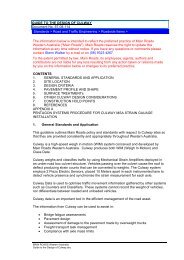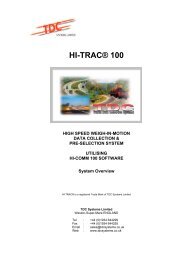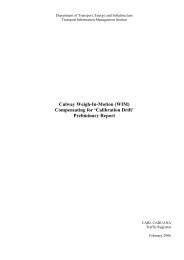Instruction Manual, Type 9195E - WIM
Instruction Manual, Type 9195E - WIM
Instruction Manual, Type 9195E - WIM
You also want an ePaper? Increase the reach of your titles
YUMPU automatically turns print PDFs into web optimized ePapers that Google loves.
Typical Configuration of a <strong>WIM</strong> Station<br />
8.3 Spacing between Two Lineas ® <strong>WIM</strong> Sensor Rows<br />
The spacing between two Lineas sensor rows depends<br />
mainly on the speed of the vehicles. The main body oscillation<br />
frequency is between 1,8 and 3,5 Hz, we recommend<br />
from experience that the spacing should be within 3 to<br />
5 m.<br />
In practice, there are good reasons to take into account,<br />
not only theoretical calculations, but also experience, for<br />
instance:<br />
The frequency spectrum strongly depends on the vehicle.<br />
Air suspension vehicles are nearer to 1 Hz than<br />
2,5 Hz for body oscillations and their damping characteristics<br />
are different from steel suspension types.<br />
Full or partial loading of vehicles severely affects the<br />
oscillation spectra, and there may be remarkable<br />
differences according to various vehicle populations per<br />
road and country.<br />
Further to body vibrations, the axle hop and tire natural<br />
frequencies are higher and important too.<br />
The overall accuracy is potentially influenced more by<br />
pavement unevenness than by a spacing of 5 m instead<br />
of 4 m. Even the slightest bumps many meters ahead of<br />
the sensors may give rise to oscillation, so the flatness<br />
between sensor and surrounding pavement is essential.<br />
An important practical aspect is that signal integration<br />
requires the individual velocities between the two<br />
sensor rows for each vehicle. Thus the longer the<br />
spacing, the higher the errors caused by acceleration or<br />
deceleration, namely at lower speeds.<br />
Therefore, in view of the many above influences and<br />
practical experience, we refrain from giving you deviation<br />
estimates for other spacing distances.<br />
Expected average velocity Recommended distance d<br />
45 - 75 km/h (30 to 45 mph) 3,5 m<br />
75 - 95 km/h (45 to 60 mph) 4,0 m<br />
>95 km/h (>60 mph) 4,5 m<br />
002-300e-07.04 (200-348e) Page 23
















